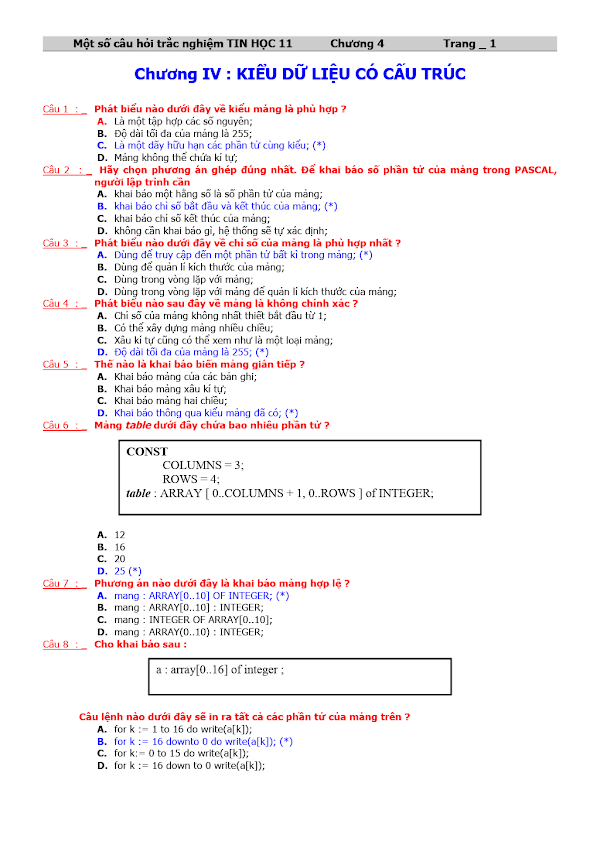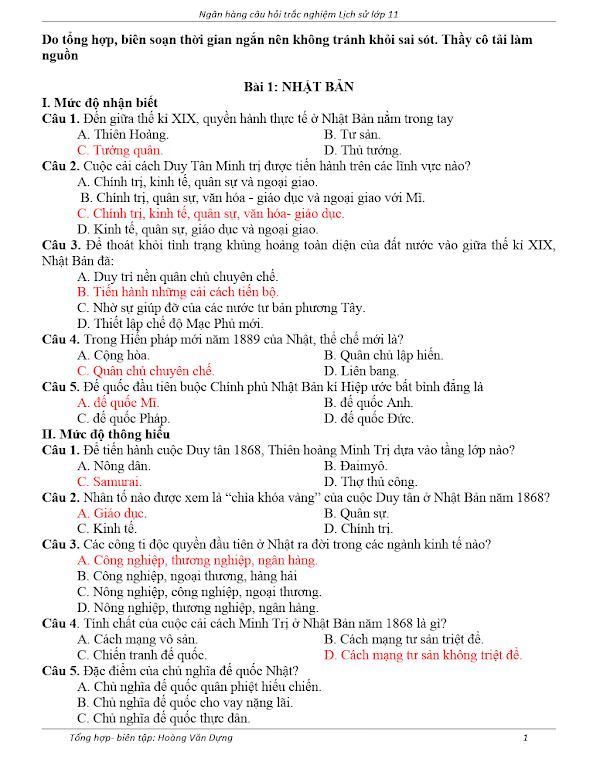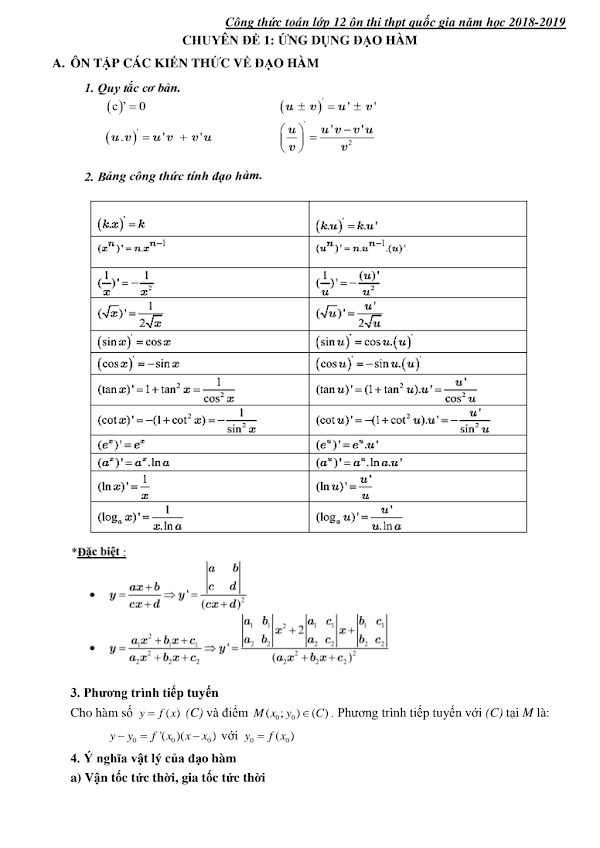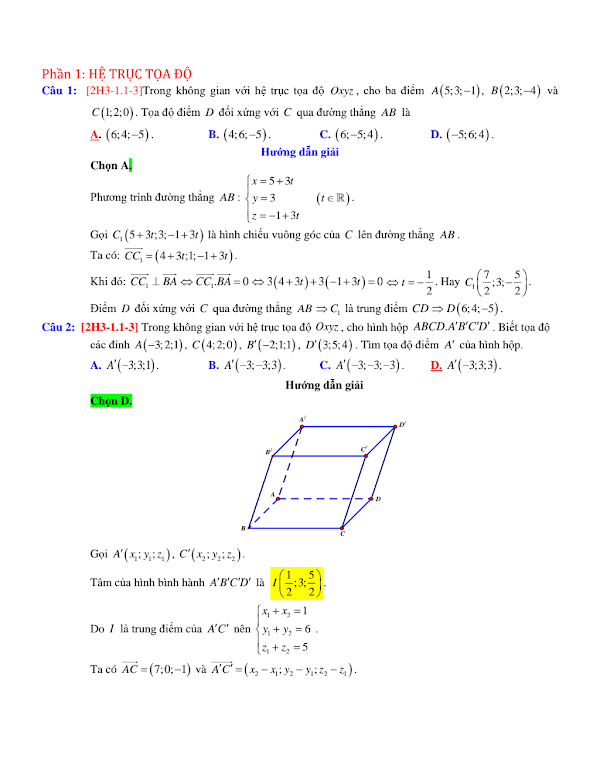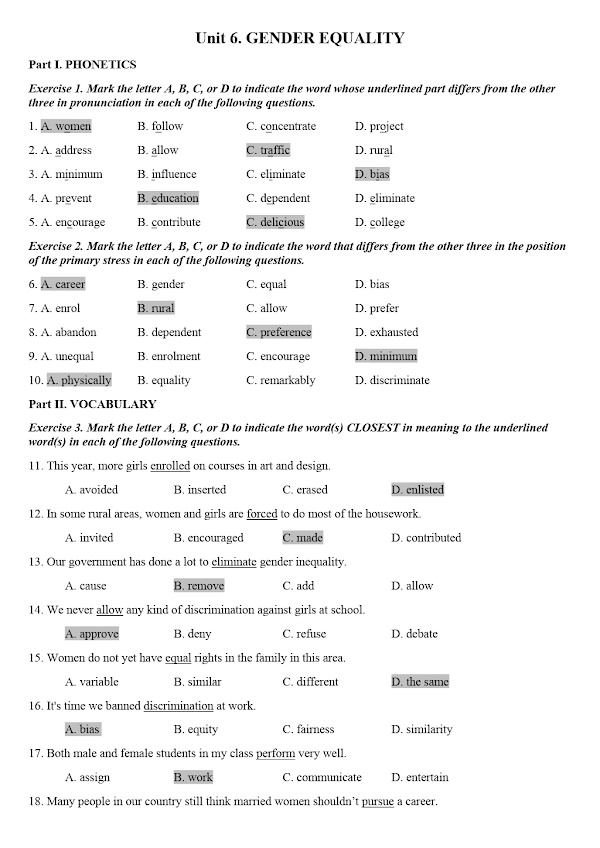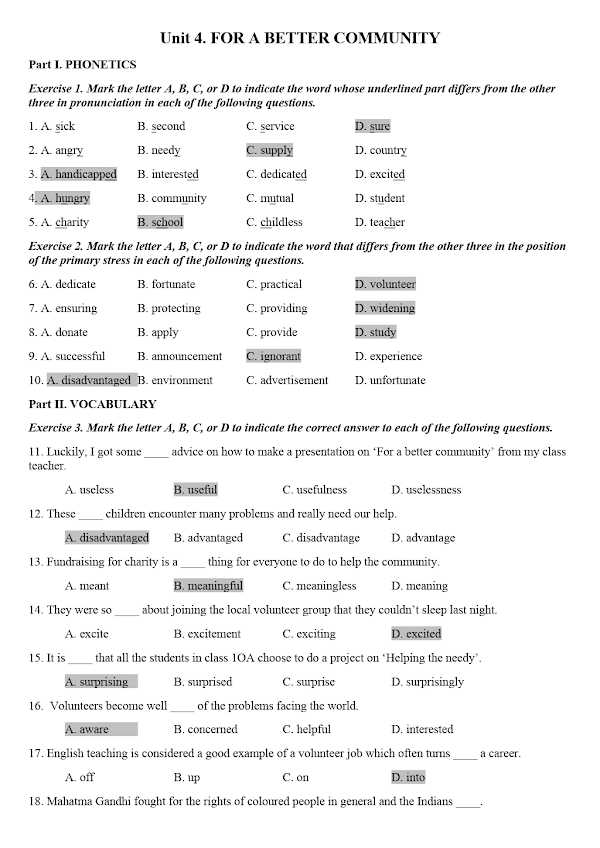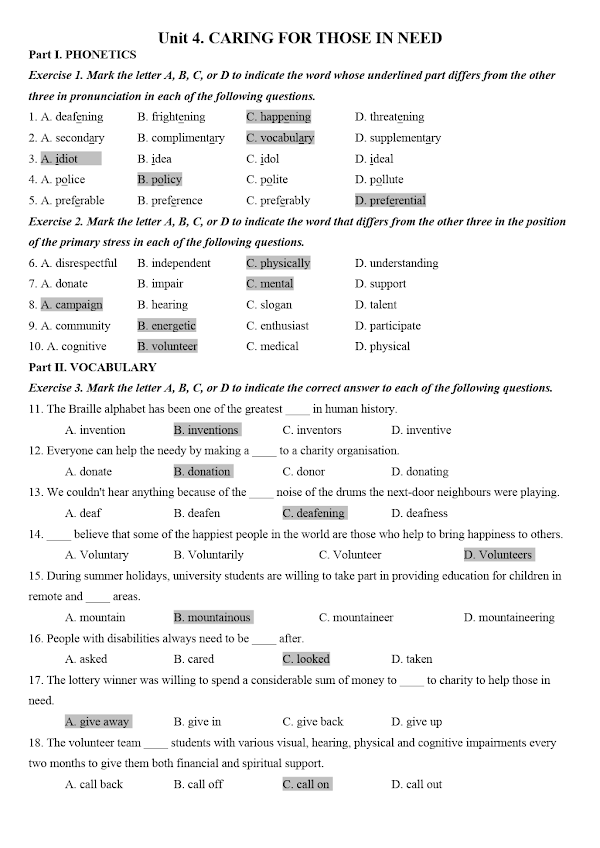04 mã đề luyện thi THPTQG năm 2020 môn Tiếng Anh
Chào các bạn học sinh và quý thầy cô, hôm nay LogaVN gửi tới bạn đọc tài liệu "04 mã đề luyện thi THPTQG năm 2020 môn Tiếng Anh". Hi vọng sẽ giúp ích cho các bạn học tập và giảng dạy.
ĐỀ THAM KHẢO LUYỆN THI TNPT 2020 - 16
Thời gian: 60 phút
Mã Đề 386
Mark the letter A, B, C, or D on your answer sheet to indicate the word(s) OPPOSITE in meaning to the underlined word(s) in each of the following questions.
01. Most of the wounded passengers were quickly removed from the aircraft.
A. healed B. injured C. diseased D. depressed
02. They are going to demolish the old theatre.
A. pull down B. rebuild C. decorate D. throw away
Mark the letter A, B, C, or D on your answer sheet to indicate the word that differs from the other three in the position of primary stress in each of the following questions.
03.A. resist B. persist C. assist D. artist
04.A. memorable B. memoirs C. memorial D. memory
Read the following passage and mark the letter A, B, C, or D on your answer sheet to indicate the correct word or phrase that best fits each of the numbered blanks from 05 to 09.
WHO WROTE IMAGINE?
Imagine, John Lennon's most famous song, was recently voted Britain’s favourite song of all time’. It’s an ...(5)... song about peace and the hope for a better world.
‘Imagine all the people living life in peace.’ The song was a big hit in 1971, and again in 1980 when Lennon was murdered in New York. It became a hit for a third time after the terrorist attacks of September 11th 2001.
But who really wrote the song? Until recently the answer to this question was always John Lennon. But on a TV programme this week Lennon’s wife. Yoko Ono, spoke for the first time about how she, in fact, helped to write the song.
Ono said that the idea and inspiration for Imagine ...(6)... from some of her poems that John Lennon was reading at that time. The poems began with the word Imagine’: ‘Imagine a raindrop, Imagine a goldfish.’ Ono said. When I was a child in Japan during the Second World War my brother and I were terribly hungry.
ĐỀ THAM KHẢO LUYỆN THI TNPT 2020 - 16
Thời gian: 60 phút
Mã Đề 386
Mark the letter A, B, C, or D on your answer sheet to indicate the word(s) OPPOSITE in meaning to the underlined word(s) in each of the following questions.
01. Most of the wounded passengers were quickly removed from the aircraft.
A. healed B. injured C. diseased D. depressed
02. They are going to demolish the old theatre.
A. pull down B. rebuild C. decorate D. throw away
Mark the letter A, B, C, or D on your answer sheet to indicate the word that differs from the other three in the position of primary stress in each of the following questions.
03.A. resist B. persist C. assist D. artist
04.A. memorable B. memoirs C. memorial D. memory
Read the following passage and mark the letter A, B, C, or D on your answer sheet to indicate the correct word or phrase that best fits each of the numbered blanks from 05 to 09.
WHO WROTE IMAGINE?
Imagine, John Lennon's most famous song, was recently voted Britain’s favourite song of all time’. It’s an ...(5)... song about peace and the hope for a better world.
‘Imagine all the people living life in peace.’ The song was a big hit in 1971, and again in 1980 when Lennon was murdered in New York. It became a hit for a third time after the terrorist attacks of September 11th 2001.
But who really wrote the song? Until recently the answer to this question was always John Lennon. But on a TV programme this week Lennon’s wife. Yoko Ono, spoke for the first time about how she, in fact, helped to write the song.
Ono said that the idea and inspiration for Imagine ...(6)... from some of her poems that John Lennon was reading at that time. The poems began with the word Imagine’: ‘Imagine a raindrop, Imagine a goldfish.’ Ono said. When I was a child in Japan during the Second World War my brother and I were terribly hungry. I imagined delicious menus for him and he began to smile. If you think something is impossible, you can imagine it and ...(7)... it happen.’
In an interview just before he died. Lennon admitted that Yoko ...(8)... credit for Imagine. He said, ‘A lot of it - the lyrics and the concept - came from her, from her book of poems, imagine this, imagine that.’ Lennon said that he was ‘too macho’ to share the credit with her at the time.
Ono said that some of the song was written when they were flying across the Atlantic and ...(9)... was written on the piano in their bedroom at their home in England. Ono said, ‘The song speaks about John’s dream for the world. It was something he really wanted to say.' Imagine became a popular song for peace activists everywhere.
In March 2002 the airport in his home town of Liverpool was re-named John Lennon Airport. A sign above the main entrance has a line from Imagine: Above us only sky'.
05.A. idealistic B. idol C. ideal D. idea
06.A. got B. went C. came D. made
07.A. have B. ask C. cause D. make
08.A. reserved B. preserved C. served D. deserved
09.A. the rest B. the next C. the other D. another
Mark the letter A, B, C, or D on your answer sheet to indicate the sentence that is closest in meaning to each of the following questions.
10. I do apologize for my forgetting your birthday.
A. I am really sorry I attended your birthday B. I do not apologize for my forgetting your birthday.
C. I'm really sorry I didn’t remember your birthday. D. I didn't forget your birthday.
11. Most boys and girls gave a great deal of thought to their future work.
A. Most boys and girls worried very much about their future work.
B. Most boys and girls thought a lot about their future work.
C. Most boys and girls felt much about their future work.
D. Most boys and girls understood a lot about their future work.
12. They couldn't climb up the mountain because of the storm.
A. The storm made it possible for them to climb up the mountain,
B. They were able to climb up the mountain thanks to the storm.
C. The storm encouraged them to climb up the mountain.
D. The storm stopped them (from) climbing up the mountain.
Choose the best answer that best fits each blank (A, B, C, or D) in the following questions.
13. Scientists are now beginning to conduct experiments on......trigger different sorts of health risks.
A. that noise pollution B. how noise pollution
C. noise pollution can D. how noise pollution can
14. He said he......me today, but so far he......
A. had phoned - hadn't B. phoned - didn't
C. will phone - doesn't D. would phone - hasn't
15. Take this umbrella.......it rains when you get home.
A. because B. in case C. as D. so that
16. We have had the television........ It's working again now.
A. to repair B. to be repaired C. been repaired D. repaired
17. Don't forget to.......your alarm clock for 6.30.
A. go off B. set C. put D. ring
18. I lost the keys to my house and had to climb in......the window. .
A. with B. to C. by D. through
19. George took.......of the fine weather to do a day's work in his garden.
A. chance B. advantage C. charge D. interest
20. I didn't know what to do but then an idea suddetlly......to me.
A. hit B. happened C. occurred D. entered
21. They......all day swimming and sunbathing at the beach.
A. passed B. occupied C. spent D. used
22. One way of cutting down waste is to.....such things as glass and paper.
A. repeat B. redirect C. renew D. recycle
23. There are geographic, economic, and cultural reasons why......around the world.
A. to differ a diet B. do diets differ C. diets differ D. are diets different
24. Because both teams came from the same town, the stadium was packed with......
A. audience B. spectators C. public D. playgoers
Mark the letter A, B, C, or D on your answer sheet to indicate the word(s) CLOSEST in meaning tothe underlined word(s) in each of the following questions.
25. We had waited for two hours and in the end they arrived.
A. suddenly B. eventually C. gradually D. luckily
26. I’m afraid of living on my own in a big city.
A. hungry B. alone C. freely D. poorly
Mark the letter A, B, C, or D on your answer sheet to indicate the sentence that best combines each pair of sentences in the following questions.
27. Nickel told them the secret. He had promised not to do so.
A. In spite of promising not to do so, Nickel told them the secret.
B. Nickel told them the secret in spite of having promised not to do so.
C. Nickel had promised not to tell them the secret in spite of doing so.
D. In spite of telling them the secret, Nickel had promised not to do so.
28. The station was full of thieves. He warned me to keep an eye on my luggage.
A. Only when the station was full of thieves, did he warn me to keep an eye on my luggage.
B. The reason why he warned me to keep an eye on my luggage was because the station was full of thieves.
C. When the station was full of thieves, he warned me to keep an eye on my luggage.
D. He warned me to keep an eye on my luggage as the station was full of thieves.
Mark the letter A, B, C, or D on your answer sheet to indicate the word whose underlined part differs from the other three in pronunciation in each of the following questions.
29.A. exact B. excellent C. exam D. exist
30.A. pegged B. lagged C. mugged D. ragged
Mark the letter A, B, C, or D on your answer sheet to indicate the underlined part that needs correction in each of the following questions.
31. Energy exists in different forms such as light, heat, and chemical, mechanic, and electrical energy.
A. electrical B. mechanic C. in D. forms
32. Though it is one of the rarest metals, gold was one of the first to be discovery.
A. discovery B. the C. metals D. Though
33. White blood cells live only for few days because they are poisoned by the bacteria they capture.
A. few B. capture C. only D. because
Read the following passage and mark the letter A, B, C, or D on your answer sheet to indicate the correct answer to each of the questions from 34 to 40.
WHY DO WE LOVE SUGAR SO MUCH?
Many scientists believe our love of sugar may actually be an addiction. When we eat or drink sugary foods, the sugar enters our blood and affects parts of our brain that make us feel good. Then the good feeling goes away, leaving us wanting more. All tasty foods do this, but sugar has a particularly strong effect. In this way, it is in fact an addictive drug, one that doctors recommend we all cut down on.
"It seems like every time I study an illness and trace a path to the first cause, I find my way back to sugar," says scientist Richard Johnson. One-third of adults worldwide have high blood pressure, and up to 347 million have diabetes. Why? "Sugar, we believe, is one of the culprits, if not the major culprit," says Johnson.
Our bodies are designed to survive on very little sugar. Early humans often had very little food, so our bodies learned to be very efficient in storing sugar as fat. In this way, we had energy stored for when there was no food. But today, most people have more than enough. So the very thing that once saved us may now be killing us.
So what is the solution? It's obvious that we need to eat less sugar. The trouble is, in today's world, it's extremely difficult to avoid. From breakfast cereals to after-dinner desserts, our foods are increasingly filled with it. Some manufacturers even use sugar to replace taste in foods that are advertised as low in fat.
But there are those who are fighting back against sugar. Many schools are replacing sugary desserts with healthier options like fruit. Other schools are growing their own food in gardens, or building facilities like walking tracks so students and others in the community can exercise. The battle has not yet been lost.
34. In line 7, the word culprit is closest in meaning to........
A. unknown thing B. cause of the problem C. disease D. sweet food
35. Which of the following statements about sugar is NOT true?
A. Sugar makes us feel good. B. Only adults need to stop eating sugar.
C. Our bodies store sugar as fat. D. We need very little sugar to survive.
36. According to the passage, why is it so hard to avoid sugar?
A. It gives us needed energy. B. We get used to eating it at school.
C. We like candy too much. D. It’s in so many foods and drinks.
37. What would be a good title for the fourth paragraph?
A. Too Much Sugar B. How to Avoid Sugar C. No Easy Answers D. A Solution: Low in Fat
38. What does the phrase the very thing in line 10 refer to?
A. having enough food to survive B. our ability to store sugar as fat
C. early humans' lack of food D. The amount of sugar in our food
39. What is this passage mainly about?
A. our addiction to sugar B. good sugar vs. bad sugar
C. illnesses caused by sugar D. ways to avoid sugar
40. The following sentence would best be placed at the end of which paragraph?
‘This may make the food appear as healthier, but large amounts of sugar are often added.’
A. paragraph 3 B. paragraph 1 C. paragraph 4 D. paragraph 2
Mark the letter A, B, C, or D on your answer sheet to indicate the most suitable response to complete each of the following exchanges.
41.
~ Kitty: "............." ~ Nelly: “I'm not sure if I'm going back home for Xmas.”
A. When are you going to spend Xmas? B. What’s wrong with you? You look not well.
C. Are you sure about your exam results? D. Are you flying home?
42.
~ Charles: “Could you look after my dog this weekend.? We want to go away.” ~ Dick: “.............”
A. No way. Don’t intend to press me. B. Certainly. I need some meat for my cat.
C. No problem. Just a slight scratch. D. Sure. I’m free then.
Read the following passage and mark the letter A, B, C, or D on your answer sheet to indicate the correct answer to each of the questions from 00 to 00.
THE BIG THAW
The Chacaltaya ski area in Bolivia used to be the highest in the world. Although it was less than a kilometre long, it hosted international ski competitions. Today the snow has almost gone, and so have Chacaltaya’s days as a popular ski resort.
The ski area sits upon a small mountain glacier, which was already getting smaller when the ski area opened in 1939. In the past ten years, however, the glacier has been melting at an increased rate. As the glacier melts, dark rocks beneath it are uncovered. The sun then heats the rocks, causing faster melting. Despite attempts to make snow with snow machines, this cycle seems unstoppable in the long run.
As experts debate how to solve the global warming problem, ice in mountains such as Chacaltaya and near the North and South Poles is melting faster than even the most pessimistic environmentalists may have once feared. Rising air and sea temperatures are two well-known causes, but researchers have recently discovered other unexpected processes that take place as glaciers melt. The effects are having an impact on humans even now, and they could change the face of the world in the future.
Serious Consequences
The glaciers of the Himalayas and the Andes could disappear in this century. As a result, the millions of people in India, Bolivia, and Peru who now depend on melting water from mountain glaciers could find themselves in a critical situation.
The ice sheet of Greenland is also melting more quickly than scientists predicted. Greenland’s largest outlet glacier, the Jacobshavn Isbræ glacier, is moving towards the sea twice as fast as it was in 1995. One cause could be meltwater that runs down to the bottom of the glacier and gets between the ice and the rock below. This water makes it easier for the glacier to slide along to the ocean.
Many ice researchers believe that Greenland’s melting, if it continues, will add at least three feet to global sea levels by the year 2100. If the ice sheet of Antarctica, now largely unaffected, begins to melt, the next few centuries could see a six-foot rise in sea levels, forcing tens of millions of people out of their homes.
How can we avoid these dire consequences of global warming? “We have to have a serious and immediate shift in attitude,” says Laurie David, producer of the prize-winning movie An Inconvenient Truth, which helped to raise awareness of the problem. Many believe that an attitude of hope and a desire to stay informed make a good beginning. An informed public is in a better position to help address this critical issue.
43. What was the author’s purpose in writing this passage?
A. to explain the problem of melting glaciers
B. to explain the causes of global warming
C. to illustrate how glaciers are formed and disappear
D. to suggest how to slow the melting of glaciers
44. What do many researchers believe will happen by the year 2100?
A. The ice sheet of Antarctica will begin to melt.
B. The melting of Antarctic ice will add 20 feet to sea levels.
C. Tens of millions of people will be forced out of their homes.
D. Global sea levels will rise at least three feet.
45. The word “dire” is closest in meaning to........
A. very great B. deadly C. too dangerous D. extremely serious
46. What is happening to the ice sheet of Antarctica?
A. It is causing a rise in global sea levels. B. It is melting dangerously quickly.
C. Its outlet glaciers are all speeding up. D. Its condition isn’t changing very much.
47. What does the pronoun “they” refer to?
A. the effects B. researchers C. unexpected processes D. humans
48. In line 7, the phrase in the long run is closest in meaning to........
A. for a long time without stopping B. in the near future
C. depending on the length of time. D. over a long period of time
49. Which of the following statements would Laurie David most likely agree with?
A. There is nothing the average person can do to affect global warming.
B. Global warming is a problem that will probably fix itself over time.
C. To prevent global warming, people need to change the way they think.
D. Global warming is a problem, but not a very serious one.
50. What is the writer’s attitude about this issue?
A. optimistic B. neutral C. hopeful D. critical
The End
More reference
HYPERLINK "https://baigiang.violet.vn/user/listpost/user_id/6246085/showall/1/entry_type/test" https://baigiang.violet.vn/user/listpost/user_id/6246085/showall/1/entry_type/test ĐỀ THAM KHẢO LUYỆN THI TNPT 2020 - 16
Thời gian: 60 phút
Mã Đề 983
Mark the letter A, B, C, or D on your answer sheet to indicate the word whose underlined part differs from the other three in pronunciation in each of the following questions.
01.A. mugged B. ragged C. pegged D. lagged
02.A. exam B. exact C. exist D. excellent
Read the following passage and mark the letter A, B, C, or D on your answer sheet to indicate the correct answer to each of the questions from 03 to 09.
WHY DO WE LOVE SUGAR SO MUCH?
Many scientists believe our love of sugar may actually be an addiction. When we eat or drink sugary foods, the sugar enters our blood and affects parts of our brain that make us feel good. Then the good feeling goes away, leaving us wanting more. All tasty foods do this, but sugar has a particularly strong effect. In this way, it is in fact an addictive drug, one that doctors recommend we all cut down on.
"It seems like every time I study an illness and trace a path to the first cause, I find my way back to sugar," says scientist Richard Johnson. One-third of adults worldwide have high blood pressure, and up to 347 million have diabetes. Why? "Sugar, we believe, is one of the culprits, if not the major culprit," says Johnson.
Our bodies are designed to survive on very little sugar. Early humans often had very little food, so our bodies learned to be very efficient in storing sugar as fat. In this way, we had energy stored for when there was no food. But today, most people have more than enough. So the very thing that once saved us may now be killing us.
So what is the solution? It's obvious that we need to eat less sugar. The trouble is, in today's world, it's extremely difficult to avoid. From breakfast cereals to after-dinner desserts, our foods are increasingly filled with it. Some manufacturers even use sugar to replace taste in foods that are advertised as low in fat.
But there are those who are fighting back against sugar. Many schools are replacing sugary desserts with healthier options like fruit. Other schools are growing their own food in gardens, or building facilities like walking tracks so students and others in the community can exercise. The battle has not yet been lost.
03. Which of the following statements about sugar is NOT true?
A. Only adults need to stop eating sugar. B. We need very little sugar to survive.
C. Our bodies store sugar as fat. D. Sugar makes us feel good.
04. What is this passage mainly about?
A. illnesses caused by sugar B. good sugar vs. bad sugar
C. our addiction to sugar D. ways to avoid sugar
05. In line 7, the word culprit is closest in meaning to........
A. cause of the problem B. sweet food C. disease D. unknown thing
06. According to the passage, why is it so hard to avoid sugar?
A. It gives us needed energy. B. We like candy too much.
C. It’s in so many foods and drinks. D. We get used to eating it at school.
07. What does the phrase the very thing in line 10 refer to?
A. our ability to store sugar as fat B. having enough food to survive
C. early humans' lack of food D. The amount of sugar in our food
08. What would be a good title for the fourth paragraph?
A. No Easy Answers B. How to Avoid Sugar C. Too Much Sugar D. A Solution: Low in Fat
09. The following sentence would best be placed at the end of which paragraph?
‘This may make the food appear as healthier, but large amounts of sugar are often added.’
A. paragraph 3 B. paragraph 2 C. paragraph 1 D. paragraph 4
Read the following passage and mark the letter A, B, C, or D on your answer sheet to indicate the correct word or phrase that best fits each of the numbered blanks from 10 to 14.
WHO WROTE IMAGINE?
Imagine, John Lennon's most famous song, was recently voted Britain’s favourite song of all time’. It’s an ...(10)... song about peace and the hope for a better world.
‘Imagine all the people living life in peace.’ The song was a big hit in 1971, and again in 1980 when Lennon was mu

